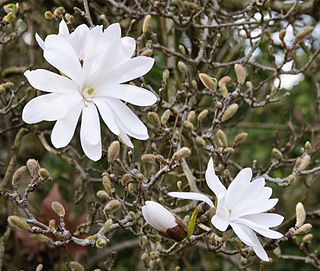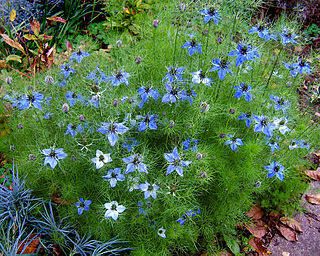
Iris is a flowering plant genus of 310 accepted species with showy flowers. As well as being the scientific name, iris is also widely used as a common name for all Iris species, as well as some belonging to other closely related genera. A common name for some species is flags, while the plants of the subgenus Scorpiris are widely known as junos, particularly in horticulture. It is a popular garden flower.

Alstroemeria, commonly called the Peruvian lily or lily of the Incas, is a genus of flowering plants in the family Alstroemeriaceae. They are all native to South America, although some have become naturalized in the United States, Mexico, Australia, New Zealand, Madeira and the Canary Islands. Almost all of the species are restricted to one of two distinct centers of diversity; one in central Chile, the other in eastern Brazil. Species of Alstroemeria from Chile are winter-growing plants, while those of Brazil are summer growing. All are long-lived perennials except A. graminea, a diminutive annual from the Atacama Desert of Chile.

Magnolia stellata, the star magnolia, is a slow-growing deciduous shrub or small tree native to Japan. It bears large, showy white or pink flowers in early spring, before its leaves open. This species is closely related to the Kobushi magnolia, and is treated by many botanists as a variety or even a cultivar of that. However, Magnolia stellata was accepted as a distinct species in the 1998 monograph by Hunt.

Nigella damascena, love-in-a-mist, or devil in the bush, is an annual garden flowering plant, belonging to the buttercup family Ranunculaceae. It is native to southern Europe, north Africa and southwest Asia, where it is found on neglected, damp patches of land.

Echeveria is a large genus of flowering plants in the family Crassulaceae, native to semi-desert areas of Central America, Mexico and northwestern South America.

Erica cinerea, the bell heather, is a species of flowering plant in the heath family Ericaceae, native to western and central Europe.

Kerria japonica, commonly known as Japanese kerria or Japanese rose, is a deciduous, yellow-flowering shrub in the rose family (Rosaceae), native to China, Japan and Korea. It is the only species in the genus Kerria. In the wild, it grows in thickets on mountain slopes. Japanese kerria has been used for medicine and is also planted in gardens. A double-flowered cultivar, K. japonica 'Pleniflora', is commonly called bachelor's buttons.

Iris pseudacorus, the yellow flag, yellow iris, or water flag, is a species of flowering plant in the family Iridaceae. It is native to Europe, western Asia and northwest Africa. Its specific epithet pseudacorus means "false acorus", referring to the similarity of its leaves to those of Acorus calamus, as they have a prominently veined mid-rib and sword-like shape. However, the two plants are not closely related. The flower is commonly attributed with the fleur-de-lis.

Iris chrysographes, the black iris, is a plant species that belongs to the genus Iris. It is native to Southern China and Myanmar (Burma), growing in meadows, streamsides, hillsides and forest margins.

Hesperantha coccinea, the river lily, or crimson flag lily, is a species of flowering plant in the iris family Iridaceae, native to Southern Africa and Zimbabwe.

Iris pallida, the Dalmatian iris or sweet iris, is a hardy flowering perennial plant of the genus Iris, family Iridaceae. It is native to the Dalmatian coast (Croatia) but widely naturalised elsewhere. It is a member of the subgenus Iris, meaning that it is a bearded iris, and grows from a rhizome. It adapts well to different environments and is used in many different ways.

Iris foetidissima, the stinking iris, gladdon, Gladwin iris, roast-beef plant, or stinking gladwin, is a species of flowering plant in the family Iridaceae, found in open woodland, hedgebanks and on sea-cliffs.

Salvia candelabrum is a species of flowering plant in the family Lamiaceae, native to Spain. It is a woody-based perennial growing to 100 cm (39 in), with woolly grey-green leaves that resemble those of the common sage, S. officinalis, and emit a similar scent when crushed. In summer it bears violet-blue flowers on branching stems held high above the foliage.

The term "Japanese iris" encompasses three species of Irises cultivated in gardens or growing wild in Japan: hanashōbu, kakitsubata and ayame. Of these three species, I. ensata is the one most commonly referred to as "Japanese iris" outside Japan.

Tectorigenin is an O-methylated isoflavone, a type of flavonoid. It ha been isolated from leopard lily, Algerian iris and East Asian arrowroot.

Irilone is an isoflavone, a type of flavonoid. It can be found in Trifolium pratense, in Iris unguicularis and in Iris germanica.

Iris ensata, the Japanese iris or Japanese water iris, formerly I. kaempferi, is a species of flowering plant in the family Iridaceae, native to Japan, China, Korea and Russia, and widely cultivated as an ornamental plant. "Japanese iris" may also refer to I. sanguinea and I. laevigata, both native to Japan.

Acer palmatum, commonly known as Japanese maple, palmate maple, or smooth Japanese maple (Korean: danpungnamu, 단풍나무, Japanese: irohamomiji, イロハモミジ, or momiji,, is a species of woody plant native to Korea, Japan, China, eastern Mongolia, and southeast Russia. Many different cultivars of this maple have been selected and they are grown worldwide for their large variety of attractive forms, leaf shapes, and spectacular colors.

Iris reticulata, the netted iris or golden netted iris, is a species of flowering plant in the family Iridaceae. It is native from eastern Turkey to Iran, but cultivated widely in temperate regions. The reticulata group of irises is characterised by a fibrous net surrounding the bulb. They are small plants to 15 centimetres (5.9 in), with tubular, sharply-pointed, ribbed leaves, and flowers of yellow, blue or purple with an orange blaze on the falls, appearing in early spring. They are hardy, but prefer a well-drained sunny position in soil which dries out in summer; they are therefore suitable for a rock or gravel garden.
Iris loczyi is a beardless iris in the genus Iris, in the subgenus Limniris and in the series Tenuifoliae of the genus. It is a rhizomatous herbaceous perennial, from a wide area of Asia, including Afghanistan, Iran, Kazakhstan, Tajikistan, Mongolia, Tibet and China. It has long thin grey green leaves, long stems and 1 flower in pale violet, blue violet, lavender or light blue.



















